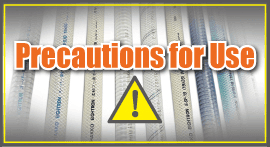Antimicrobial Hose [Model Number: AM]
Anti-Bacteria, Anti-microbial Hose | Reduce the Generation of Biofilm | This hose is suitable for transferring food and beverage, since it inhibits the bacteria growth.
Fluids
 food
food drink
drink cosmetics
cosmetics alcohol
alcohol water
water Applications
- For Water Purifier Hose
- For Transferring Beverages and Drinking Water
- For Transferring Beverages and foods (Food Machinery)
- For Food Grade Hose
- For Transferring Cosmetics and Pharmaceuticals, including Pharmaceutical Raw Materials
Functions
Low Elution
Low Odor
Food-Sanitation
Flexibility
Washability
Light Weight
RoHS 2 Free
Characteristics
- Anti-Microbial Feature...Inorganic antimicrobial agent is added to the inner layer of AM, which keeps a hose to have the feature of anti-microbial.
- Various Colors Available...Depending on your request, various colors (such as gray and white) are available.
- Non-PVC...AM is made of non-PVC materials, which contains less smell than PVC water purifier hose. (Depending on your request, PVC type is also available.)
- Twin Hose...Twin hose (one for supply and the other for drainage) is available on your request.
- RoHS Compliant...AM is compliant with RoHS requirements (Directive: (EU) 2015/863). (RoHS Compliant means that AM does not contain RoHS 10 restricted substances or it does not exceed the upper threshold of RoHS 10 restricted substances.) Certificate is available on request.
- Food Sanitation...AM conforms to the Food Sanitation Law No.370 (No.370 of the Ministry of Health and Welfare for Food Sanitation). (Conformity to N-Heptane). Certificate is available on request. [For more information on compliance with the revised Food Sanitation Law (Effective on June 1, 2020), please contact us from here.]
Product Standard
Made-to-Order Product (Example Sizes)
Single Type
Twin Type
- Temperature Range : 0 - 60 $^\circ$C (32$^\circ$F - 140$^\circ$F)
- Color : Gray or White
*If you are interested in this Made-to-Order Product, please fill out the following form. (Please note that we can also produce a size that is not listed on the table above.)
Made-to-Order Inquiry Form
Why do we need an anti-microbial hose?
(a) Risk of Bacteria Growth
Bacteria might grow in the following situations of transferring food, beverages and other fluids.
1: Hose ends are exposed.
2: The fluid remains in the hose.
3: When the inner layer of the hose is exposed to air while bacteria are still adhered to it after fluid transfer is completed.
(2) What is the definition of anti-bacteria?
According to JIS Z 2801 (ISO 22196), antibacterial is defined as "Conditions that inhibit bacterial growth on the surface of the product."
(a) Antibacterial
To make it difficult for a bacterium to live by making it unable to live for a certain period of time or to grow more. It is not to kill or reduce bacteria, but to suppress their growth.
(b) Eradication of Bacteria
To improve cleanliness by reducing the number of objects such as objects and liquids and microorganisms contained in a limited space.
(c) Disinfection
To neutralize toxicity by killing pathogenic microorganisms, reducing them to a harmless level, or reducing their infectivity.
(d) Killing Germs
It is to kill microorganisms, but the target and degree are not defined.
(e) Sterilization
To completely kill and remove all viable microorganisms including microorganisms. It is a term used mainly for medical instruments used in surgery.
(3) HAKKO Antibacterial Hose
The above (2-a) "Antibacterial" feature can be added to the hose that maintains hygiene.
*If you request a WRAS approved hose, please contact us from here.
Technical Information
Anti-microbial Test
The specification of antibacterial agent shows antibacterial effect against Staphylococcus aureus.
*For more information on the followings, please feel free to ask us.
・Anti-Bacteria Agent
・Mechanisms of Anti-Bacteria
・Anti-Bacterial Spectrum Data













